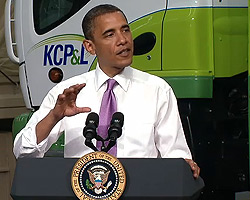 Summertime, and the living won’t be easy. From electricity to groceries to clothing, the cost of everything you need, and of most things you want, has increased. But there are few places where Americans have felt the sting of higher prices more profoundly than at the gas pump. And you don’t have to own a car to feel it; just get on a plane, take the train — heck, catch a cab.
Summertime, and the living won’t be easy. From electricity to groceries to clothing, the cost of everything you need, and of most things you want, has increased. But there are few places where Americans have felt the sting of higher prices more profoundly than at the gas pump. And you don’t have to own a car to feel it; just get on a plane, take the train — heck, catch a cab.
As we begin to pack up the family car for that long-awaited summer vacation at Grandma’s house, a gallon of gasoline averages $3.80, $1.07 more than this time last year. Maybe you can just email Grandma a photo of the kids instead.
Or better yet, maybe President Barack Obama could address workers at a research facility funded by a $528.7 million stimulus-act grant to develop a new alternative mode of energy-efficient transportation: airborne porcine units (also known as “flying pigs”). Although the facility won’t have produced a commercially viable prototype, Obama could go on to express confidence that, with additional government investment (aka “spending”), the needed technology breakthroughs would be achieved. I can hear him now: “When pigs fly, my energy policies will be vindicated, and the taxpayer dollars we have committed to this effort will greatly lessen our dependence on foreign oil.”
Fantasy? Of course, but then again, taxpayers are on the hook for a $528.7 million loan to a company seeking to make plug-in electric cars that the Obama administration announced with great fanfare in 2009. The result? That company recently breathlessly announced that it plans to sell a car for the bargain price of $96,850 that charges in “as little as six hours” and has — wait for it — a 50-mile range before a backup gasoline engine kicks in.
If all goes well (and it hasn’t so far), the company says, it hopes to sell, eventually, 15,000 vehicles per year worldwide. That is less than 1/100th of 1 percent of the vehicles now on America’s roads. For this we spent more than $500 million?
President Obama also flew into Kansas City, Mo., to tout Smith Electric Vehicles, a firm that received Recovery Act funds to build all-electric, zero-emissions commercial trucks as “the promise of a brighter future.” The reality, though, is that nearly the same percentage of Americans will commute to work today on flying pigs as will pull out of their driveways in fully electric vehicles — a real taxpayer-subsidized panacea that the president claims will solve our energy problems.
Hope is not a strategy, and wishful thinking is not a policy. And yet when it comes to energy, the president is literally tilting at some pretty expensive windmills.
The Real Energy Challenge for America
In a fall 2007 article for the Journal of International Security Affairs, I noted that in the era of global terror, security of the oil supply had trumped pricing of that supply in the energy calculus. For decades, U.S. energy policy was based on creating a military defense umbrella around the Arabian Peninsula in order to guarantee the steady supply of crude oil from exporters like Saudi Arabia, Kuwait, the United Arab Emirates, Iran and Iraq.
And while the warning signs of the problems inherent in this arrangement were plentiful — the Arab oil embargo of the 1970s, the Iranian hostage crisis, the Beirut embassy bombing, the decade-long Iran-Iraq War, and war between the U.S. and Iraq — it took an event like Sept. 11 to focus the public’s attention on our dysfunctional relationship with the region.
 In his 2006 State of the Union address, President George W. Bush declared that America is “addicted to oil” and outlined a goal of reducing our dependence on oil imports from the Middle East by 25 percent by 2020 through a combination of conservation and fuel diversification. President Bush also noted that part of his “Advanced Energy Initiative” would include increased funding for “research in better batteries for hybrid and electric cars, and in pollution-free cars that run on hydrogen.”
In his 2006 State of the Union address, President George W. Bush declared that America is “addicted to oil” and outlined a goal of reducing our dependence on oil imports from the Middle East by 25 percent by 2020 through a combination of conservation and fuel diversification. President Bush also noted that part of his “Advanced Energy Initiative” would include increased funding for “research in better batteries for hybrid and electric cars, and in pollution-free cars that run on hydrogen.”
The reality, however, is that “investment” in such programs is still very expensive and speculative, and in order for our economy to continue to grow, America will continue to rely on oil imports to fuel our economic growth for decades to come. It is prudent, then, for U.S. policymakers to put greater emphasis on diversifying our current set of energy suppliers while seeking a more cost-effective and U.S.-centric energy policy.
The pinch at the pump is a national wakeup call that we are not in control of our energy sources; we don’t even have an energy policy that leads us to energy independence and efficiency. Instead we find ourselves held captive by the oil politics of Venezuela, China’s ravenous oil consumption, instability in the Middle East and aggressive oil speculation on Wall Street.
After three decades of both Republican and Democrat Congresses and presidents, we are still no further along in creating true energy independence through a commonsense, comprehensive energy policy.
Investing in What Works
The president continues to insist that if we throw tens of billions of taxpayer dollars (ideally spent in key swing states) at faddish energy initiatives, those massive sums, combined with the magic elixir of “hope” (which, in this context, may be more accurately characterized as wishful thinking), will overcome basic principles of both science and economics. His policies, Obama tells us, will transform technological toads into princes, and bring down the prohibitive costs of investment and research into alternative fuel sources to affordable levels (or, at least, mask those costs and shift them to taxpayers through massive subsidies).
The sole determinant of what should be included among our nation’s energy policies is whether something works — not whether it is popular among the self-congratulatory environmental scolds of Manhattan’s Upper West Side. We absolutely should promote conservation and energy efficiency, but those efforts will be successful only if they acknowledge technological and economic realities.
Standard filament lightbulbs and gasoline-powered internal combustion engines are proven, affordable technologies that should be further refined to become more efficient, not treated as crimes against humanity. Even incremental improvements in the energy consumption of these items will confer far greater benefits than the energy alternatives that have provided the backdrop for so many presidential photo ops, and have consumed so many billions of taxpayer dollars.
 Also, if we are serious about reducing our dependence on foreign oil — a doubtful premise with this administration — we must do more to develop our domestic energy resources. And yes, that means, dare I say it, “Drill, baby, drill!” to increase offshore oil development. But I am not the only one to say it. President Obama recently acknowledged in a national radio address the need to increase domestic oil production in order to reduce high gas prices.
Also, if we are serious about reducing our dependence on foreign oil — a doubtful premise with this administration — we must do more to develop our domestic energy resources. And yes, that means, dare I say it, “Drill, baby, drill!” to increase offshore oil development. But I am not the only one to say it. President Obama recently acknowledged in a national radio address the need to increase domestic oil production in order to reduce high gas prices.
Well, he didn’t actually use those words, but he did order the interior secretary to begin annual lease sales for drilling in Alaska’s Natural Petroleum Reserve. It’s a start.
As much as the president has pretended otherwise, the laws of supply and demand cannot be repealed. It took $4 gas to convince him that current supplies are inadequate and will only get worse as the energy consumption of other rapidly industrializing countries continues to grow.
Our nation finds itself ever more vulnerable to global instability, Mother Nature and economic uncertainties because we remain beholden to old strategies, failed solutions and tenuous alliances. We can no longer afford them.
Nor can we afford to borrow and spend precious taxpayer dollars ($42 billion in stimulus funding) on so-called energy initiatives, each more delusional than the next. With such an extravagant outlay of pork on such unworkable schemes, I just want to know: How many miles will I be able to fly my new pig before it’s time to fill ‘er up again?
(This article re-printed, with permission from the author, from TheRoot.com)










Leave a Reply